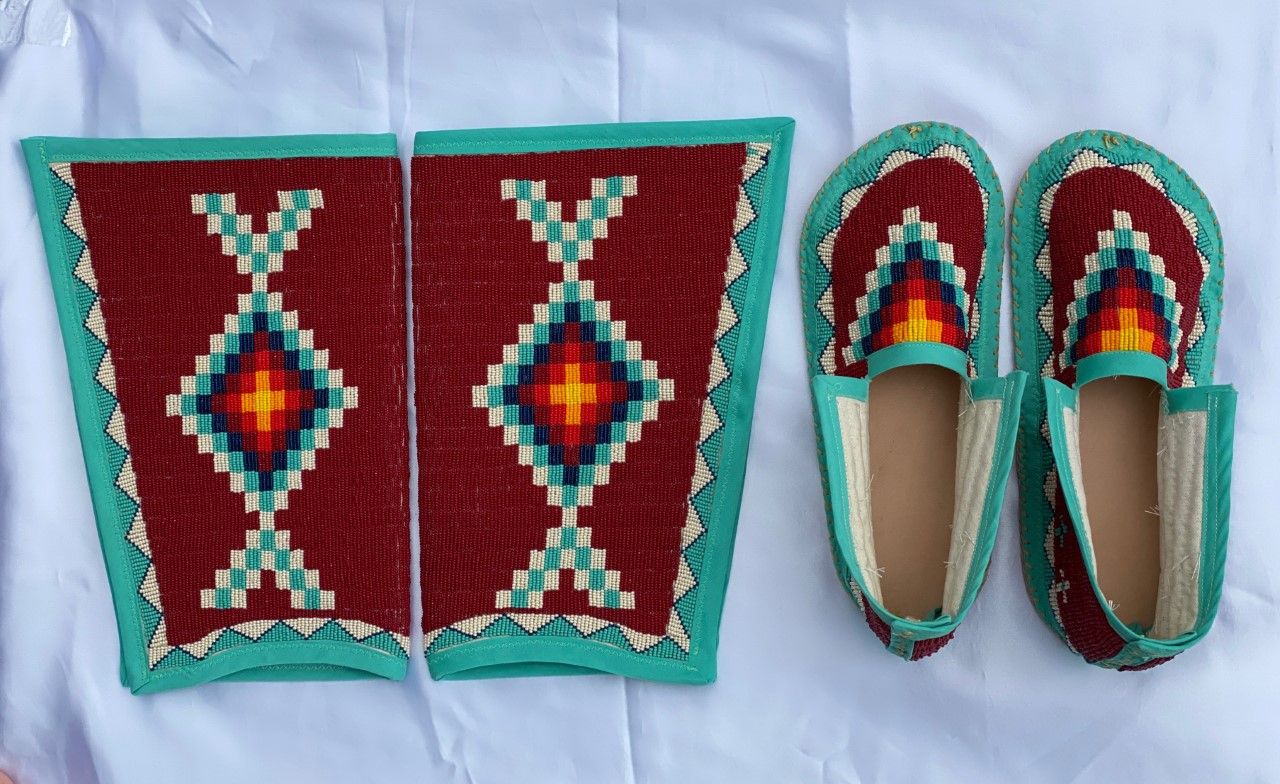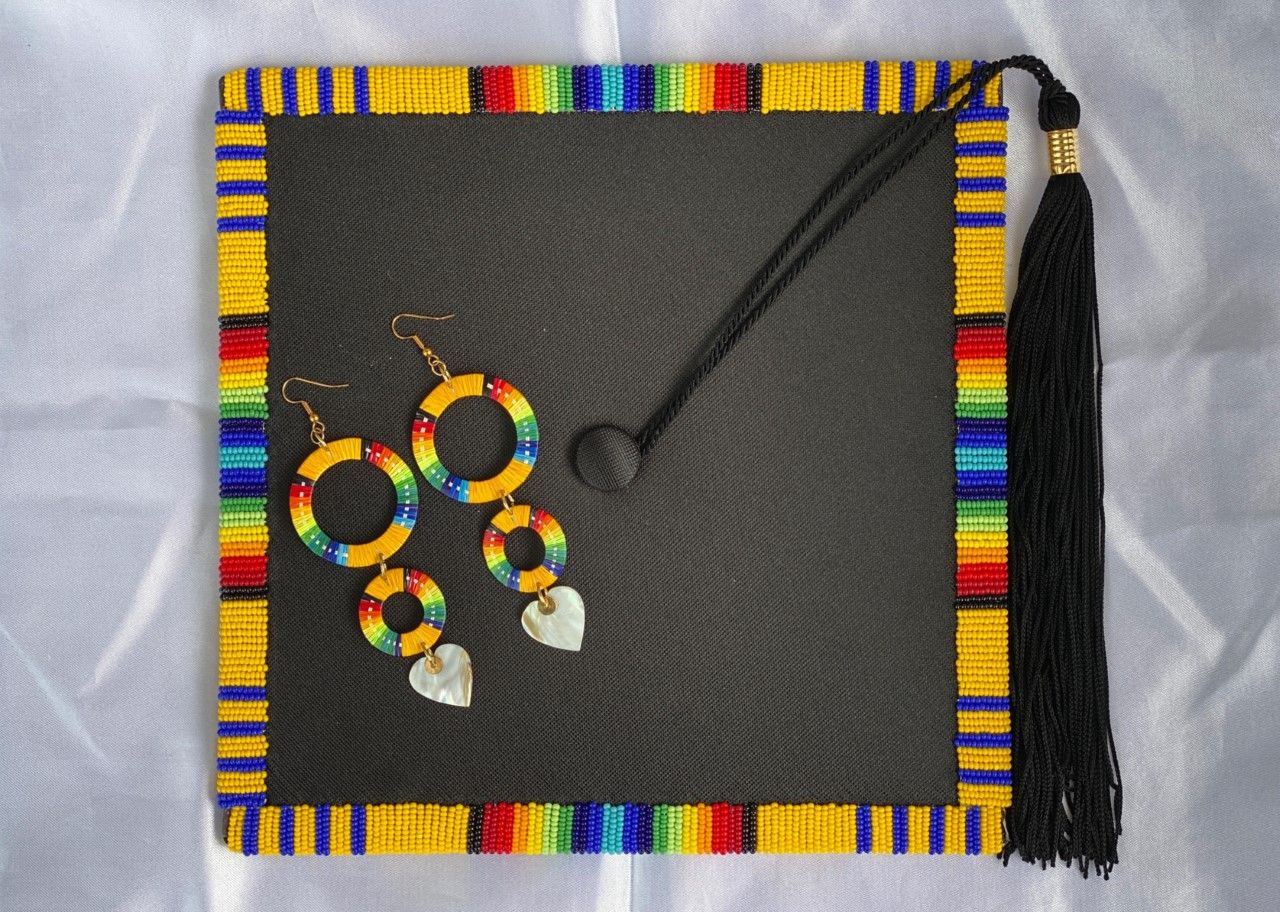What might seem like just a needle picking up beads is so much more. There is a plethora of information that follows with it. I’m grateful that exhibits like the one at the GALT can teach both Indigenous and non-Indigenous people the significance of beadwork and the cultural knowledge that follows with it.
When COVID hit, Kalli Eagle Speaker (BASc ‘21) spent hours in her living room, carefully picking up beads with her needle, transforming each individual bead into beautiful patterns on cloth. In a stressful and unprecedented time, for Kalli, beadwork is a destressing tool, a way of honouring her heritage and connecting with family. Kalli is an old-style jingle dress dancer, currently in the process of making herself a new set of beading to wear, letting her good energy flow into her steady hands and releasing the fear and sadness that the pandemic brought. As the pandemic ends, her ‘anxious beading’ has turned into a beautiful project.

“I learned at a very young age how to bead, and I’m very fortunate that my sister and mom have been able to teach me. From the many stories I’ve been told, my great-grandmother farmed, sewed, and crafted. She was an entrepreneur. Unfortunately, my mom was in that age range where her parents went to residential school, so there was a massive gap in cultural ways of knowing. But my mom was determined to gain that lost knowledge and to ensure my sister and I were knowledgeable,” Kalli explains. Her older sister picked up beading quickly and was able to teach Kalli, and the sisters learned together. “There’s a difference between doing the craft and learning the history behind it. Even to this day, we are still learning traditional designs, colours, family and ceremonial designs,” she adds.
This June, Kalli will be receiving her Bachelor of Arts & Science, majoring in Indigenous studies and psychology with a minor in women and gender studies (WGST). At uLethbridge Kalli, worked as a teaching assistant in Dr. Paul McKenzie Jones’s first-year Indigenous studies class, as an applied study, after completing an independent study with Dr. Carol Williams, a WGST and history professor and the director of the Centre for Oral History & Tradition.
It was the summer of 2020, shortly after COVID had taken over, and Dr. Williams and PhD student, Hali Heavy Shield, were already working on a project about Kainaiwa beadwork. Dr. Williams felt it would be beneficial for Kalli to work alongside them on the project. “I felt very confident talking about something with which I was familiar. I’m from Kainai myself,” Kalli remembers. Kalli and Dr. Williams conducted weekly literature reviews and compiled relevant ones together into sources. After that process, Kalli began her own original research, something she hadn’t done before.
“Dr. Williams was a massive help for me,” she says. Kalli appreciated the independence she had to work through her study, as well as the support. She hadn’t done research alone before, and the online medium added another layer of difficulty. But eventually, Kalli finished interviewing five candidates from Kainai, one of whom was her sister, Torry. “It was a significant learning process for me. Utilizing recording equipment, exchanging forms back and forth with people who might not be technologically literate, and the move from reading and writing to virtual person-to-person meetings was initially a challenge.”
Kalli went through field notes and transcribed them, organized her paper with all the literature and interviews, and began putting it together. “I honestly wasn’t expecting such an elaborate process, but Dr. Williams was an amazing support! She helped me organize my thoughts and create categories from the interviews and literature. Thus, my paper was written!” Following this independent study, Dr. Williams hired Kalli to work on a larger project displayed at the GALT museum. “My independent study actually led me to work as a colleague with Dr. Williams and Hali Heavy Shield for our Galt Museum exhibit titled Blackfoot Iiksisawaato’p Kainaiwa O’tookátákssin: Maana’pii ki niita’piitsitapii saatstakssin, which in English translates to We Visit with Kainaiwa Beadwork: A New Way and the Real Way of Design. Right now, my interview and photo panels are all at the GALT. It’s been a long and tedious process, but that’s how I ended up with this award,” Kalli smiles.
Kalli finished her year as a winner of the HistoriCity Essay Award. After Dr. Williams pointed out that her paper met the essay prize requirements, Kalli decided to submit it. “I gave it a shot, and honestly, I forgot about it because I was doubtful it would go anywhere. I was out doing errands just the other day, and I was blown away to hear I’d won. I received an influx of congratulation emails, which goes to show how supportive the uLethbridge community is of student’s accomplishments,” Kalli explains. This accomplishment represents a beautiful summation of Kalli’s undergraduate work.
Kalli says, “What might seem like just a needle picking up beads is so much more. There is a plethora of information that follows with it. I’m grateful that exhibits like the one at the GALT can teach both Indigenous and non-Indigenous people the significance of beadwork and the cultural knowledge that follows with it.” As for beading misconceptions, Kalli has a lesson to share. “When you go to a mall, you might see some beading pieces that are a poor reflection of what the craft is truly about. Many aren’t aware that Indigenous people are still doing beadwork. A lot of Indigenous history and Blackfoot history is very ‘of the past,’ but in reality, we’re all still here, and we’re still practicing.” Kalli cleared up another common misconception. “It’s important to acknowledge that both Indigenous and non-Indigenous people can bead and wear beadwork, so long as they’re respectful. It’s also very respectful when non-Indigenous people ask questions, instead of assuming things, because we’re all still learning, and we’re not trying to gatekeep the knowledge.”
Reflecting on her uLethbridge experience, Kalli admits she wasn’t always the established academic she is now. “I was 17 when I started at the University of Lethbridge, and I was the youngest of my class. I had moved from living on the reserve my entire life and going to a small-town high school, to joining a massive institution. It was a culture shock, learning new ways and experiencing the city,” she admits. Kalli put incredible stress on herself to get from point A to point B. But after a tough first semester, Kalli persevered and overcame her imposter syndrome. “I started going to my academic advisors and my professors. The U of L is small enough that if you’re reaching out for help, they will remember you.” When she began utilizing her professor’s office hours, Kalli’s grades improved dramatically. She adds, “I wish I could tell my younger self to build relationships with my professors. Something I learned from my project, turning from a paper to a literal job, is that one interaction, project or even conversation with a professor can open up so many different opportunities and doors for you, even at the beginning of your undergraduate career.”
After some well-deserved time off post-graduation, Kalli plans to return to school the next year and pursue a master’s in counselling psychology. She hopes to one day practice as a registered psychologist and continue Indigenous research throughout a PhD program. “Hopefully, I will be able to work with my people in the Blood Reserve. Mental health has been very important to me my whole life, and I think now more than ever, especially during the pandemic, we fail to recognize how significant these resources are,” she notes. “Indigenous people need to be able to access these resources with an indigenous counsellor or psychologist. We need more of those within the mental health field.”
